Many hobbyists use aquarium salt to treat minor health problems in most tropical and coldwater freshwater species of fish.
But can using aquarium salt help or harm your betta fish?
Well, aquarium salt is known to accelerate the healing process and reduce inflammation in betta fish that are recovering from an illness or injury. The salt can also be helpful when used in small doses as a preventative measure for bettas prone to certain infections or diseases.
So, should you add salt to your freshwater fish tank routinely? Can aquarium salt kill betta fish if you use too much? And is aquarium salt safe for bettas?
Read this detailed guide to learn the answers to those questions and discover more about using aquarium salt safely in your betta tank!
What Is Aquarium Salt?
Aquarium salt is a form of salt that’s specifically formulated for use in freshwater aquariums. This form of salt is mostly comprised of sodium chloride (NaCl) but also contains certain trace elements and minerals that are known to be beneficial for fish health, including magnesium, calcium, and potassium.

When used in moderation, aquarium salt has many benefits for your betta fish, including improving gill function, aiding in healing wounds, external infections, and certain mild illnesses, reducing inflammation, promoting the correct essential electrolyte balance in your fish tank, and disrupting the lifecycle of harmful organisms.
Never use table or marine salt in your betta tank! These salts’ composition is unsuitable for use in freshwater tanks and could harm your betta buddy.
Why Use Aquarium Salt For Betta Fish?
There are quite a few benefits to using aquarium salt for betta fish.
However, as with any form of water treatment and fish medication, you must use aquarium salt with caution and in moderation. Prolonged or excessive exposure to salts can harm your betta, so you must always follow the recommended dosage and treatment duration.
Stress Reduction
Adding aquarium salt to your fish tank water can help reduce stress in bettas and other tropical fish species by regulating the fish’s osmotic balance, making it easier for the fish to cope with environmental changes.
That can be handy when bringing your new betta home or introducing new tank mates.
Treating and Preventing Diseases

Aquarium salt is known to have mild antibacterial and antifungal properties, and adding it to the water can be helpful in treating several common ailments in fish, including fungal infections and fin rot.
Salt creates a hostile environment that many common pathogens hate, making it difficult for them to grow and spread.
Slime Coat Support
Tropical fish, including bettas, have a protective layer of mucus on their skin called a slime coat. The slime coat helps to protect the fish from parasites, infections, and other external stressors, and aquarium salt can help enhance and support the slime coat and keep diseases and infections at bay.
Improved Healing Process
Aquarium salt can assist in healing external injuries, including open wounds and sores, fin rot, tail biting, and lost scales, by creating a saline environment that encourages faster tissue repair and regeneration.
Maintain Kidney Function
Your betta buddy’s kidneys play a crucial role in maintaining the water and electrolyte balance within his body.
Adding aquarium salt to the tank water is thought to help the kidneys by reducing their workload of removing excess water from the fish’s body while maintaining the correct electrolyte balance.
What Are The Drawbacks Of Using Aquarium Salt?
Although aquarium salt does bring benefits to your betta tank, using it can have a few drawbacks.
Fish Sensitivity
Some freshwater fish species, such as certain scaleless fish, catfish, and tetras, cannot tolerate aquarium salt in their environment, and using it can stress the fish, adversely affecting their health.
Invertebrate Sensitivity
Many hobbyists keep a few invertebrates as tank mates for their betta fish, but some species of aquatic life, including snails and shrimp, are more sensitive to salt than fish.
Medication Interaction
If you’re using aquarium salt as part of a disease treatment or recovery program, you must be aware that salt can interfere with the efficacy of some stronger medications and can render the drugs less effective.
That can make it much harder to treat your fish effectively, potentially leading to further complications, secondary infections, and even the death of your precious pet.
Plant Problems
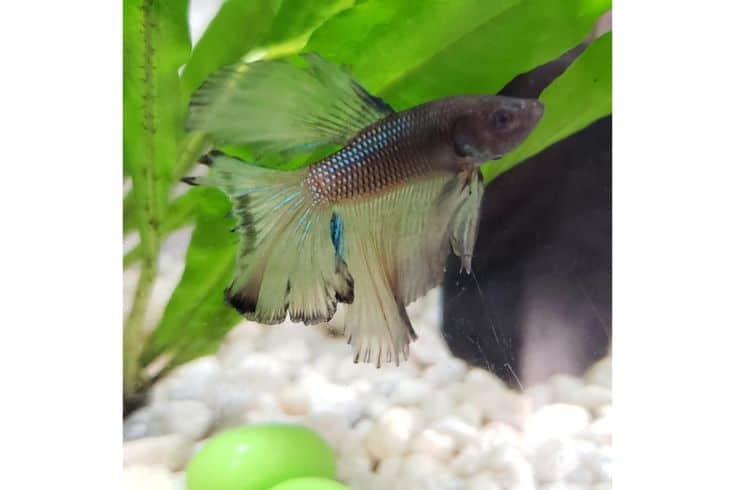
I always grow a wide variety of aquatic plants in my fish tanks, and bettas love them for the shelter and resting places the plants provide. Unfortunately, aquarium salt can inhibit plant growth, and some fragile plants simply won’t tolerate even mildly saline conditions.
Osmoregulation Issues
As mentioned earlier, salt affects the osmoregulation process in fish, improving the creature’s ability to maintain the correct balance of water and salts in the fish’s body.
Although that can be a benefit for your betta fish, prolonged exposure to salt can disrupt the delicate balance of the fish’s internal systems, potentially causing dehydration and other health problems.
What Betta Diseases Can Aquarium Salt Treat?
Aquarium salt, when used in the correct amount, can be used to treat the following common fish diseases that sometimes affect bettas:
- Fin and tail rot
- Ich
- Minor fungal infections
- Minor bacterial infections
- Popeye
- Swim Bladder disease
That said, treating the tank with salt most likely won’t cure these diseases and should only be used as an aid to recovery in conjunction with appropriate disease-specific medication.
What Can’t Aquarium Salt Treat?
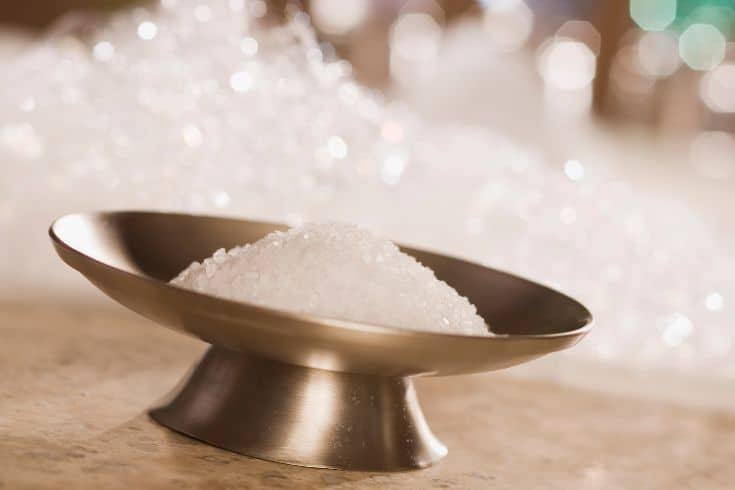
There are several conditions that aquarium salt isn’t effective against, including the following:
Serious Bacterial Infections
Although you can use aquarium salt to treat minor bacterial infections, it’s not a reliable option when it comes to dealing with serious or longstanding severe infections.
In that case, you’ll need to use antibiotics or a specific antibacterial medication that your vet can prescribe.
Severe Fungal Infections
Although some mild fungal infections can benefit from treatment with aquarium salt, it won’t have much effect against more serious fungal problems.
In severe cases, the best treatment is an antifungal medication that’s specifically formulated for aquarium fish. You can find antifungal treatments at your local fish store, with the best ones containing methylene blue or malachite green, both of which I’ve used to treat severe fungal infections in my fish successfully.
The main drawback to using both those treatments is that they color the aquarium water bright blue or green, depending on what product you choose. However, the frequent water changes you’ll need to carry out during treatment will quickly remove the color from the water.
Parasites

Most external parasites and flukes cannot be despatched by using aquarium salt. The most effective way to get rid of flukes is to use a specific anti-parasitic medication to disrupt the parasite’s lifecycle and ultimately kill off the infestation.
However, aquarium salt can be helpful in boosting your betta’s recovery once the parasites have been eliminated.
Internal Diseases
Aquarium salt isn’t effective against diseases and infections affecting the fish’s internal organs. Instead, you’ll need to use a specific, targeted medication that’s effective against the particular cause of the problem.
Poor Water Quality
Aquarium salt is not a substitute for good fish tank maintenance, and using it won’t help to cure problems caused by poor water quality.
If your tank water has high levels of ammonia, nitrite, and nitrates, or pH imbalances, you’ll need to give your tank a thorough clean, check that your filtration system is working correctly, and be sure that your tank is fully cycled.
Going forward, be sure to keep on top of regular partial water changes and maintain your filter media properly, replacing it when necessary in line with the manufacturer’s guidelines.
How To Use Aquarium Salt For Betta Fish Correctly
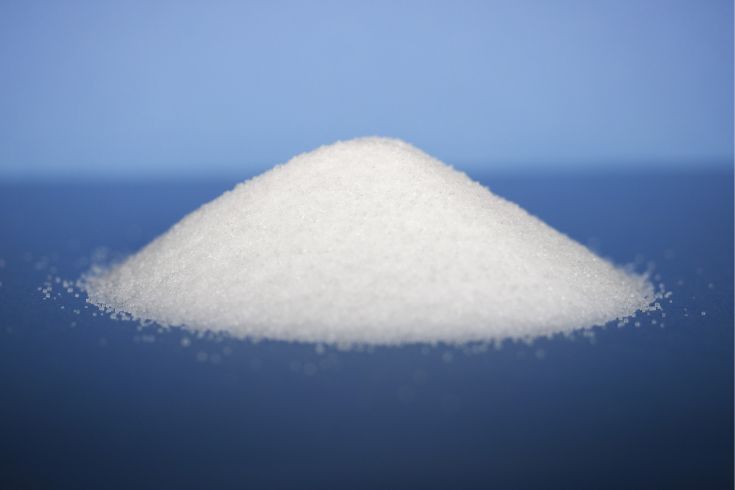
If you decide to use aquarium salt to treat your betta fish, it’s essential that you use it correctly in the right quantity and for the right period of time.
If you don’t want to treat your whole tank, you might prefer to use a salt dip or betta salt bath instead.
Here’s what you need to know.
Choose The Right Kind Of Salt
Aquarium salt is specifically formulated for use in the freshwater aquarium.
Do not use regular salt, regular table salt, sea salt, or any kind of salt designed for human consumption in your betta aquarium! These forms of salt can contain additives such as flavor enhancers that could potentially harm your betta!
Measurement Of Salt
Don’t just tip a load of salt into your fish tank and hope for the best! To get the full benefits of aquarium salt, you must use the correct amount.
Too large a dose of aquarium salt could kill your betta, whereas too little won’t be effective, so it’s crucial that you use the correct amount of salt when treating your betta fish.
As a general guideline, we recommend using 1 teaspoon of aquarium salt per gallon of tank water. That said, it’s best to start with lower dosages of salt content than that, gradually increasing the aquarium salt concentration if necessary.
For a mild treatment or for general electrolyte supplementation, use half the recommended dose of salt of half a teaspoon of salt per gallon of water.
Prepare The Tank
I recommend you remove any live aquarium plants from the tank, as they could be sensitive to the salt.
However, if you have a large community tank with lots of aquarium plants and other livestock that could be adversely affected by the salt, it’s best to treat your betta fish in a separate quarantine tank.
Dissolve The Salt
Don’t just tip the salt into your fish tank, as that can irritate your fish. Instead, measure the required amount of salt and dissolve it in a separate container filled with water taken from your betta buddy’s tank. The warm water will dissolve the salt completely, leaving you with a clear solution to add to the tank.
Add The Salt To Your Betta’s Tank
Introduce the dissolved salt gradually to the betta tank so that you don’t suddenly change the water parameters in the tank dramatically, which could stress your betta fish.
Ideally, you should drip the saline solution into the tank over the course of at least an hour or so, starting with a small amount and gradually increasing it.
Monitor Your Betta
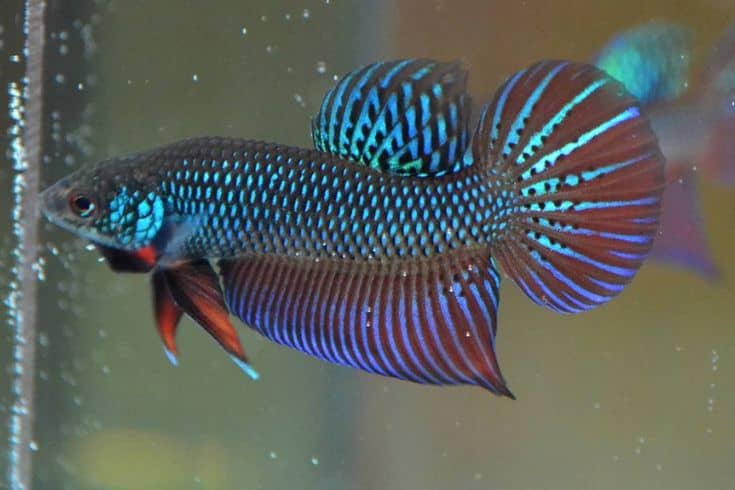
Throughout the course of your aquarium salt treatment, keep a close eye on your betta. As a general rule of thumb, your pet should start to show signs of improvement after a few days.
Most bettas can tolerate aquarium salt, although a few can’t, so be prepared to remove your betta from the salty water if he shows signs of distress.
Discontinuing Salt Treatment
Once the treatment period has finished, gradually reduce the original salt concentration in your betta’s tank by carrying out partial water changes over a few days so that the water chemistry in the tank returns to normal and the salt water is replaced with fresh water.
Aquarium Salt Alternatives
There are several safe alternatives available that you can use to treat your betta fish.
Epsom Salt
Epsom salt is more correctly known as magnesium sulfate and is commonly used as an alternative to aquarium salt, especially for fish that benefit from the addition of magnesium in their habitat.
Epsom salt is generally used as a tonic to promote fish health, relieve stress, and support the treatment of common fish diseases.
Kosher Salt
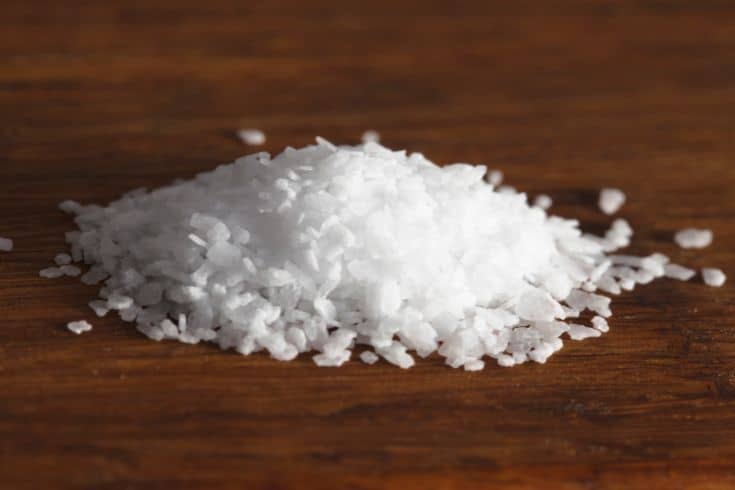
Kosher salt can often be a suitable alternative to aquarium salt, provided you check that the salt doesn’t contain any additives or anti-caking agents that could harm your betta fish.
Rock Salt
Rock salt or halite can be used instead of aquarium salt. However, again, you must check that the salt doesn’t contain any additives or impurities that could be dangerous for your fish.
FAQs
Here are the answers to a few of the most commonly asked questions about using aquarium salt in your betta tank.
Q: How long should I keep my betta in aquarium salt?
A: You can leave aquarium salt in your betta tank for four to five days.
Q: Can bettas tolerate aquarium salt?
A: Yes, bettas can tolerate small doses of aquarium salt.
Q: Do I add aquarium salt every day?

A: No, we don’t recommend using salt on a daily basis as a health booster or preventative treatment since it changes the water chemistry.
It’s often best to use a separate salt bath or salt dip to treat your betta fish rather than dosing the whole tank.
Q: What are the benefits of aquarium salt?
A: Aquarium salt promotes betta health by improving gill function and providing essential natural electrolytes that promote color and vitality. Salt can also be effective in helping to treat and prevent some fish diseases.
Q: How long to treat betta fin rot with aquarium salt?
A: Aquarium salt should be used to treat fin rot for around 7 days.
Final Thoughts
Did you find our guide to using aquarium salt to treat your betta fish helpful? If you did, please hit the share button above!
Aquarium salt can be a useful complement to medications used to treat several common fish diseases, promote a healthier slime coat, and act as an electrolyte to balance osmoregulation. Always use the correct dosage of aquarium salt when treating your fish, and discontinue treatment after a maximum of one week.
We’d love to know if you use aquarium salt in your tank! Tell us more in the comments box below!
